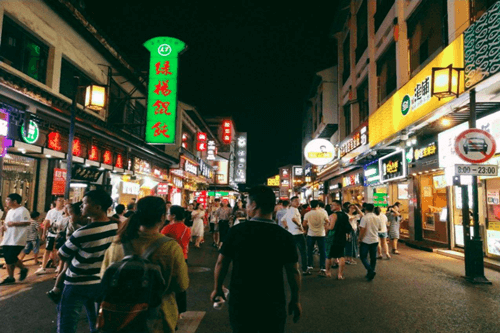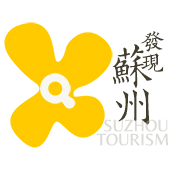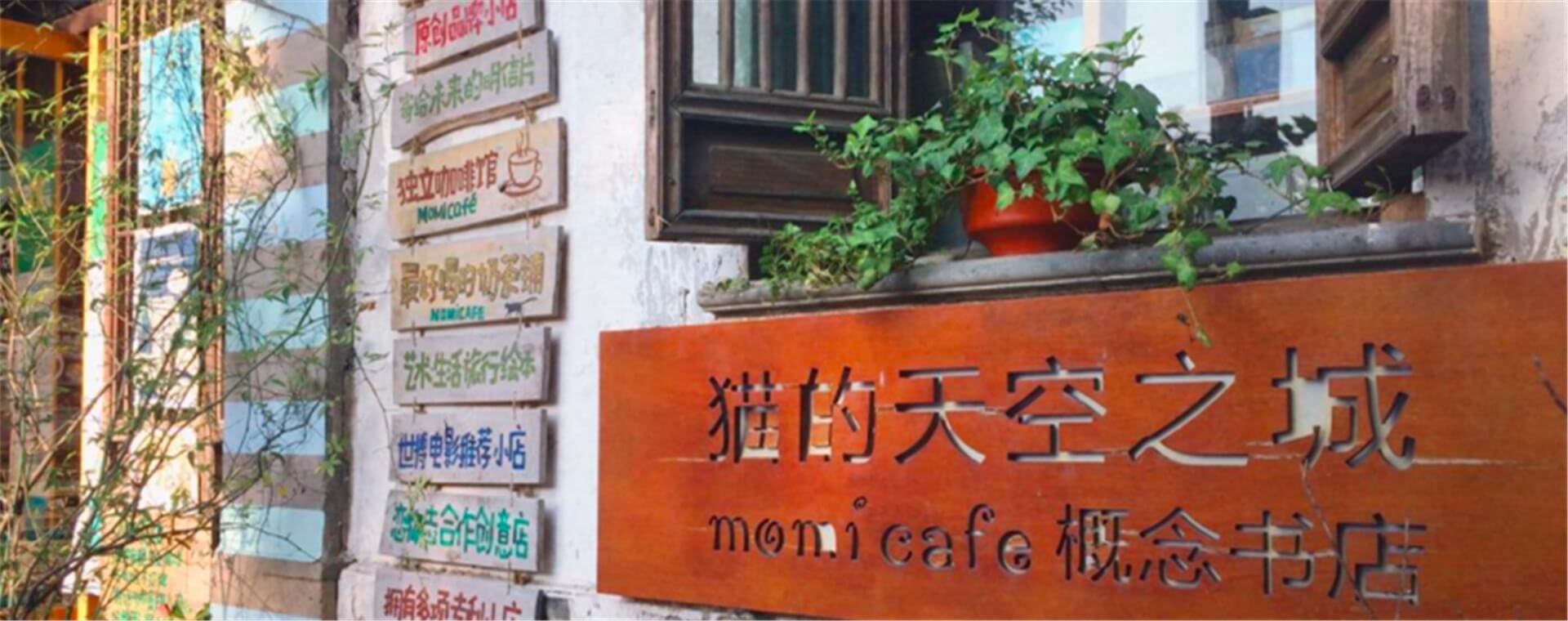Address:Gusu District, Suzhou City

Historical evolution
In Song Dynasty, Xuanmiao temple was named Tianqing temple. Therefore, the street is called Tianqing Temple front, also known as broken brocade street.
In the Yuan Dynasty, tianqingguan was renamed Xuanmiaoguan, and the street name was changed to Xuanmiaoguan Qian, then Guanqian Street.
In 1930, Guanqian Street was widened and rebuilt.
After liberation, Guanqian Street was expanded and renovated for many times, first with small square stone pavement, then with asphalt pavement, and the street width gradually increased to 9-13 meters.
In June 1982, Guanqian Street was changed into a pedestrian street.
From 1999 to 2001, Guanqian Street was renovated in three phases.

Architectural composition
Guanqian Street main street is 780 meters long, east of Pingjiang Road historical and cultural block, south facing Suzhou Park, West Suzhou Town God’s Temple, North Suzhou Railway Station and North Temple Pagoda Temple.
Guanqian Street uses the principle of “Confucianism and Taoism complement each other” and takes Xuanmiaoguan as the core. At the same time, a stall market is set up on the east side of Gongxiang corresponding to Beiju square to cooperate with Xuanmiaoguan square, forming a three-point symmetrical layout. Guanqian Street is composed of six functional areas. Each area has one or two core facilities, such as comprehensive shopping malls as the “core”, and a series of auxiliary facilities, such as professional stores as the “wing”, forming a “core with wings” layout. Among them, the modern commodity area is located in the section from Renmin intersection to the west side of Beiju, with people’s shopping mall as the core and other professional stores extending to its side; the cultural entertainment area is centered on Beiju square, surrounded by four cinemas and bookstores, and equipped with Western food and other service facilities; the local snack area is located in the east side of Beiju and in front of Xuanmiaoguan, Taking the food street as the core, all kinds of snacks are arranged in the small square; Gongmei rest area takes Xuanmiaoguan as the theme, and the East and West cities mainly sell local arts and crafts goods; the comprehensive market area is Gongxiang street, with the stall market as the core; the local characteristic commodity area extends from the east side of Xuanmiaoguan to the Qiaokou of vinegar square, combined with time-honored shops, with comprehensive shopping malls.

Architectural features
Building

Guanqian Street is located in the ancient city area, there are clear height building restrictions, which make the building volume small and form a low building outline. In the use of architectural color, in addition to the use of specific yellow in Xuanmiao temple, it is mainly black, white and gray.
Lighting

Guanqian Street mainly has light pole lamp, courtyard lamp, floor lamp, projection lamp, neon lamp and so on. The shape of the lamps in Guanqian Street integrates the architectural elements of traditional Suzhou gardens, presents the style of Jiangnan gardens, and maintains the main colors of “black, white and gray” in color.
Sculpture
The story of an old man and a child is described in the work “crying vendor” in Guanqian Street. The sculpture is based on a sugar porridge stand in the 1950s. There are stoves, pots and bowls on the camel’s shoulder. With seasoning, it reflects the characteristics of Suzhou snacks. The costumes of the characters are also Suzhou traditional styles, such as the old man’s “diditou” cotton hat, Chinese cotton padded jacket, apron at the waist, clam shell cotton shoes on the feet, and children’s tiger head cap and tiger head shoes, which reproduce the food characteristics and life scenes at that time.

Greening
Guanqian Street is dominated by native tree species, such as Cinnamomum camphora, Osmanthus fragrans, Ginkgo biloba, etc. In the main commercial street, due to the large flow of people, the movable tree pool is often used, supplemented by ground cover plants.
Guanqian Road is located in the center of Suzhou, not far from Suzhou railway station. It is an old commercial street in Qing Dynasty. Now it has been transformed into a pedestrian street, which is about 800 meters long. It is a famous snack street and commercial street in Suzhou with its radiated road eunuch lane and Bi Feng Fang. It is equivalent to the Confucius temple in Nanjing and Town God’s Temple in Shanghai.
Main attractions
Xuanmiao Temple
Xuanmiao temple is located in the center of Guanqian Street. It was founded in 276, the second year of Xianning in the Western Jin Dynasty. It was initially named Zhenqing Taoist temple. Yuancheng Zong Yuanzhen first year (1295), known as Xuanmiao temple. During the Hongwu Period of Ming Dynasty, Zhu Yuanzhang reorganized the religion, granted Xuanmiao temple in Suzhou as Zhengyi jungle, and set up an organization to manage Taoist affairs, Daoji department, in the temple. In the Qing Dynasty, in order to avoid the Emperor Kangxi’s taboo, Xuanmiaoguan was changed to yuanmiaoguan, also known as yuanmiaoguan. It was not until after the Republic of China that the old name of Xuanmiaoguan was restored.
Eunuch Lane
Eunuch lane is located in the south of the middle section of Guanqian Street, which is an inner street of Guanqian Street. All the emperors of the Ming Dynasty sent eunuchs to Suzhou to supervise the weaving Bureau, and there were a number of middle and small eunuchs as assistants. Most of the eunuchs lived in Lilong near the weaving Bureau. Because they lived there for a long time, they got the name “eunuch lane”. In the 1930s, eunuch Lane had zhengxingguan, Xuangong, Sanwu, daxinyang, Jueling, shishilin and other restaurants. In the early 1980s, eunuch lane was redesigned and built into a food lane, known as “Chisha eunuch lane”. Songhelou, deyuelou, Shanghai laozhengxing, wangsi restaurant, Gongdelin and other time-honored restaurants all gathered in this lane.
Specialty
Lu Jianjian meat shop
Lu’s meat shop was founded in 1663, the second year of the reign of Emperor Kangxi of the Qing Dynasty. Its “Lu’s hoof” was made of “Hu pig” from Taihu Lake Basin, and the honey sauce duck from loumen duck in Suzhou.
Ham shop
Shengchunyang ham shop, formerly known as juchengxiang leg Inn, was founded in Tongzhi period of Qing Dynasty. It bought ham from Jinhua, Dongyang, Yiwu, Rugao and other places, and gradually became a time-honored brand in Suzhou curing industry.
Candy store
Mr. Jin Yinzhi, a snowman in Guanqian Street, set up a stove to boil sugar at the entrance of Zhusi lane, and managed two pieces of zongzi sugar for a penny. In 1884, Jin Yinzhi rented the front of an antique shop in caizhizhai. With the help of his son, he set up a candy shop and operated self-made Su style candy, fried goods and preserves. Because there was no shop name, customers still called caizhizhai, and Jin pushed the boat along the river, so he officially hung up the sign.
Huang Tianyuan cake Group shop at the east gate of Xuanmiao temple was founded in 1821, the first year of Daoguang reign of Qing Dynasty. Zaoni yam cake, which was written in Chapter 11 of a dream of Red Mansions, is one of its specialties.
Pine and crane tower
Songhelou was founded in 1737, the second year of Qianlong reign of Qing Dynasty. It was a noodle shop at the beginning, mainly selling stewed duck noodles and strong chicken noodles. At the end of the Qing Dynasty, Su Bang cuisine was operated, including mandarin fish with squirrel, Qingyu Dayu (shrimp), shark’s fin with original sauce, steamed pork with lotus leaf powder, crab bowl with snow flake, herring throwing water, etc.

